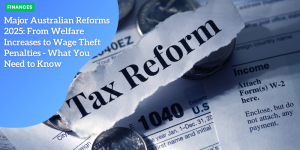Australian Education Reform: How 3 Million Students Could See Debt Slashed
Anúncios
Australia has taken a significant step towards easing the financial burdens of student debt with the recent passage of a debt relief bill in the House of Representatives.
This new legislation aims to cap the HECS-HELP indexation rate, which could potentially slash $3 billion in student loans for over three million Australians.
Under this bill, the indexation rate will be adjusted to the lesser of the consumer price index (CPI) or wage price index (WPI), ensuring that student loan debts increase at a more controlled and predictable rate.
One of the most impactful features of this bill is the automatic credit system.
The Australian Taxation Office (ATO) will backdate the credit to June 1, 2022, helping to adjust and reduce student loan debts based on the newly implemented lower indexation rates.
This means that graduates who have been grappling with rising student loans due to high inflation rates may see immediate relief.
Education Minister Jason Clare has highlighted that a typical graduate with a $26,500 loan might see an average debt reduction of around $1,200.
This targeted approach not only provides immediate monetary relief but also aims to prevent future surges in student loan balances.
Additionally, credits will be refunded to those who repaid their loans after June 2022, ensuring fairness and equity in the new system.
This bill is more than just a financial adjustment; it’s a significant step towards making higher education more accessible and reducing long-term financial stress for students.
Although the bill awaits Senate approval, its potential for positive impact on Australian students is undeniable.
Key Features of the Debt Relief Bill
Capped Indexation Rates
One of the most significant aspects of the Debt Relief Bill is its promise to cap the indexation rate for HECS-HELP loans.
Specifically, the legislation aims to ensure that the indexation rate will be capped at the lower of either the Consumer Price Index (CPI) or the Wage Price Index (WPI).
This reform is a considerable shift designed to alleviate the burdens of ever-increasing student loans, making repayments more manageable for graduates in the long term.
Automatic Credit Backdated to June 1, 2022
Another crucial feature of the Debt Relief Bill is the automatic credit that will be backdated to June 1, 2022.
This measure ensures that any adjustments in the indexation rate are applied retroactively, effectively reducing the total amount owed by students who have already been repaying their loans under higher indexation rates.
This retrospective action is aimed at providing immediate relief to millions of Australians, demonstrating the government’s commitment to supporting higher education.
Impact on Over 3 Million Australians
The Debt Relief Bill is not a small-scale initiative; it impacts over three million Australians who have taken out HECS-HELP loans.
This group includes students and graduates from various educational backgrounds, making the bill’s reach both extensive and inclusive.
By applying these features broadly, the legislation seeks to create a more equitable educational landscape where financial constraints are less of a barrier to higher education.
As we move forward, other related initiatives like the Universities Accord Bill and practical support payments further aim to enrich the educational experiences of future generations.
Impact on Individual Students
The Debt Relief Bill promises substantial benefits for individual students, primarily by reducing the financial burden of HECS-HELP loans.
This legislation could provide an average debt reduction of $1,200 for those with a typical $26,500 loan.
This reduction can offer much-needed relief to many graduates struggling with the weight of student debt.
Average Debt Reduction
For a graduate with an average debt of $26,500, this translates to nearly $1,200 in savings.
Given the cap on the HECS-HELP indexation rate at the lower of the Consumer Price Index (CPI) or Wage Price Index (WPI), this legislation aims to create more predictable and manageable repayment scenarios for students.
Refunds for Early Repayments
Another noteworthy aspect of the bill is its provision for refunds.
Graduates who have repaid their loans after the indexation date of June 1, 2022, will receive refunds for any overpayments made due to higher indexation rates.
This adjustment will be managed by the Australian Taxation Office (ATO) and provides a direct financial benefit to those who proactively managed their debts since last year.
Wider Accessibility to Higher Education
Reducing student debt not only provides immediate financial relief but also fosters broader accessibility to higher education.
Lower financial barriers mean more Australians can pursue higher education without the looming concern of insurmountable debt.
This can lead to more equitable access to university programs, encouraging a more diverse and educated workforce.
With these changes, over 3 million Australians could benefit from reduced financial pressure and greater educational opportunities, setting a precedent for future reforms.
The next steps focus on introducing practical support payments, starting July 2024, and expanding FEE-FREE University Ready Courses.
Additional Educational Reforms
Universities Accord Bill
The Australian government isn’t just stopping at debt relief.
The introduction of the Universities Accord Bill marks a significant step forward in ensuring more comprehensive support for students in higher education.
This new legislation aims to provide practical support payments for students in fields like teaching, nursing, midwifery, and social work, recognizing the crucial roles these professions play in society.
Starting July 2024, about 68,000 students will benefit from these targeted payments, helping them focus more on their studies and less on financial burdens.
Expansion of FEE-FREE University Ready Courses
High school graduates often find the transition to university challenging, both academically and financially.
To bridge this gap, the Australian government plans to expand the FEE-FREE University Ready Courses.
This initiative aims to offer more students tuition-free preparatory courses, making higher education accessible to a broader audience.
By leveling the playing field, these courses can help ensure that students from various backgrounds have an equal opportunity to succeed in university, thus fostering a more inclusive educational environment.
These reforms collectively indicate a strong commitment to educational equity and workforce readiness.
Looking forward, these initiatives will help create a more diverse and educated workforce, benefiting not just individual students but also the broader Australian society.
Next Steps and Implementation
Pending Senate Approval
The Debt Relief Bill’s journey is not over yet.
While it has successfully passed through the House of Representatives, the Senate’s approval is still pending.
This next step is crucial for the bill to become law and bring the much-needed financial relief to students.
Automatic Credits by the Australian Taxation Office
Once the bill gets the Senate’s green light, the Australian Taxation Office (ATO) will play a key role in its implementation.
The ATO will apply automatic credits to student loans, reflecting the difference between the current and new indexation rates.
This process will be backdated to June 1, 2022, ensuring that students receive the maximum benefit from these changes.
For those who have already repaid part of their loans after June 2022, the ATO will issue refunds directly to their bank accounts.
Timeline for Practical Support Payments
Looking ahead, the practical support payments for specific fields like teaching, nursing, midwifery, and social work are set to start from July 2024.
This initiative, part of the Universities Accord Bill, aims to provide financial assistance to around 68,000 students, further easing their educational financial burdens.
These changes signify a substantial shift in Australia’s approach to student debt, aiming to create a more accessible and equitable education system.
As the nation awaits the Senate’s decision, students and their families can start to plan for a future where education is more financially attainable.







